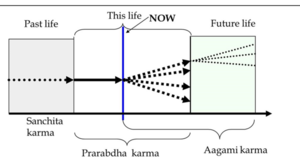Talk:Classification of Puruṣhakāra Karm: A Time Perspective
By Vishal Agarwal
Karm[1]Performed in the present time results in latent effects called ‘Saṃskāra-s’ which are of two types – Karmāśaya Saṃskāra-s and Vāsanā Saṃskāra-s. These ripen (Karmavipāka) at an appropriate time to give us the ‘fruit’ (Karmaphala) in future time. These latent effects as well as the fruit of old karm in turn influence our future actions. Likewise, our present karm is influenced by the fruit/latent effects of our past karm. What this means is that it is not accurate or feasible to divide our karm into ‘action’ and ‘fruit’ very easily. As a modern saint says:
“Karm is far greater than the mere sum of a person’s actions, for it includes both the effects of those actions which are the causes, and the impressions or tendencies created in the subconscious mind by those actions. We speak of the cause and effect relationships between actions and their results as the Law of Karm. This law governs the plan of human life and consciousness with the same exactness as do the laws of mechanics on the physical plane. Key factors in the working of karmic law are the saṃskāra-s, or “impressions” deposited in the lake of the subconscious mind as a person’s character, circumstances and activities….” [2]
For this reason, action and its latent effects and result (saṃskāra-s/karmaphala) are both often designated with the same term ‘karm’. For example, when we say that ‘Rāma’s karm is good’, it could mean either that ‘Rāma performs good karm,’ or it could also mean that ‘Rāma’s stock of saṃskāra-s/karmaphala from previous virtuous deeds is good.’
And because dharm itself primarily comprises of performing karm, the same logic applies to the twofold use of the word ‘dharm’. In other words, ‘dharm’ stands not merely for doing one’s duty (or performing virtuous acts) but also stands for the fruit of dhārmic acts. The words ‘dharm’ and ‘(good) karm’ are often used interchangeably. The model of Saṃcita, Prārabdha and Āgāmī karm explains well the duality of karm as the action, as well as its fruit, and influences in future action. Diagrammatically, this model may be depicted below:[3]
References[edit]
- ↑ The three types of Karmas (Sanchita, Prārabdha and Kriyamāna) are mentioned in Devībhāgavata Purāṇa 4.2.7 and in many other sacred texts.
- ↑ Swami Rama. Freedom from Bondage of Karma. Himalayan International Institute of Yoga Science & Philosophy of USA, 1977, Honesdale, PA (USA) pp. 6
- ↑ Created by my friend Sudhee Subrahmanya.

